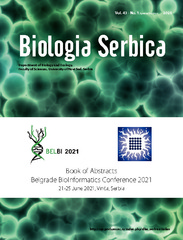Приказ основних података о документу
Genetic diversity analysis of microsatellites and mitochondrial Cytb gene, relatedness estimates and Cytb phylogeography of protected Griffon vulture species from Serbia
| dc.creator | Davidović, Slobodan | |
| dc.creator | Jelić, Mihailo | |
| dc.creator | Marinković, Saša | |
| dc.creator | Kukobat, Mila | |
| dc.creator | Mihajlović, Milica | |
| dc.creator | Tanasić, Vanja | |
| dc.creator | Hribšek, Irena | |
| dc.creator | Sušić, Goran | |
| dc.creator | Dragićević, Milan | |
| dc.creator | Tanasković, Marija | |
| dc.creator | Stamenković-Radak, Marina | |
| dc.date.accessioned | 2021-06-28T13:21:08Z | |
| dc.date.available | 2021-06-28T13:21:08Z | |
| dc.date.issued | 2021 | |
| dc.identifier.issn | 2334-6590 | |
| dc.identifier.uri | https://radar.ibiss.bg.ac.rs/handle/123456789/4254 | |
| dc.description.abstract | Abstract Once a widespread species across the region of Southeast Europe, the Griffon vulture is now confined to small and isolated populations across the Balkan Peninsula. The population from Serbia represents its biggest and most viable population that can serve as an important reservoir of genetic diversity from which the birds can be used for the region’s reintroduction programs. The available genetic data for this valuable population are scarce and it is necessary to assess its genetic diversity and inbreeding level if the population is going to be used for restocking and reintroduction. To assess the genetic diversity we used microsatellite markers from ten loci and mitochondrial Cytb nucleotide sequences. The blood samples were collected from 58 unrelated birds during the marking in the nests. We have performed a comparative analysis of newly obtained data on microsatellites and Cytb with existing data. Genetic differentiation analysis between different native populations of French Pyrenees, Croatia and Israel identified two genetic clusters that differentiate populations from the Balkan and Iberian Peninsulas. Genetic diversity analysis based on microsatellites demonstrated similar levels among all populations while analysis of Cytb detected somewhat lower diversity in the population from Serbia. Further analyses demonstrated that all analyzed populations experienced a recent bottleneck event. Phylogeographic analysis based on Cytb sequences showed that the most frequent haplotype is found in all Griffon vulture populations and that each population possesses private haplotypes. Considering the serious recent bottleneck event which the population from Serbia experienced we estimated the overall relatedness among the birds from this population. The level of inbreeding was relatively high and on average it was 8,3% while the mean number of relatives for each bird was close to three. Our data suggest that, even though a relatively high level of inbreeding can be detected among the individual birds, the Griffon vulture population from Serbia can be used as a source population for restocking and reintroduction programs in the region. The observed genetic differentiation between the populations from the Iberian and Balkan Peninsula suggest that the introduction of foreign birds should be avoided and that local birds should be used instead. | sr |
| dc.language.iso | en | sr |
| dc.publisher | Novi Sad: Department of Biology and Ecology, Faculty of Sciences, University of Novi Sad | sr |
| dc.relation | Ministry of Nature Protection of the Republic of Serbia (Grant No. 401-00-745/2019-05) | sr |
| dc.relation | info:eu-repo/grantAgreement/MESTD/inst-2020/200007/RS// | sr |
| dc.relation | info:eu-repo/grantAgreement/MESTD/inst-2020/200178/RS// | sr |
| dc.rights | openAccess | sr |
| dc.rights.uri | https://creativecommons.org/licenses/by-nc-nd/4.0/ | |
| dc.source | Belgrade BioInformatics Conference 2021: Book of Abstracts; 2021 Jun 21-25; Vinča, Serbia | sr |
| dc.subject | Population genetics | sr |
| dc.subject | Microsatellites | sr |
| dc.subject | Cytb sequencing | sr |
| dc.subject | Genetic diversity | sr |
| dc.subject | Phylogeography | sr |
| dc.subject | Inbreeding | sr |
| dc.title | Genetic diversity analysis of microsatellites and mitochondrial Cytb gene, relatedness estimates and Cytb phylogeography of protected Griffon vulture species from Serbia | sr |
| dc.type | conferenceObject | sr |
| dc.rights.license | BY-NC-ND | sr |
| dcterms.abstract | Танасић, Вања; Драгићевић, Милан; Јелић, Михаило; Сушић, Горан; Хрибшек, Ирена; Давидовић, Слободан; Танасковић, Марија; Стаменковић-Радак, Марина; Маринковић, Саша; Кукобат, Мила; Михајловић, Милица; | |
| dc.rights.holder | © 2021 the authors | sr |
| dc.citation.issue | 1 | |
| dc.citation.volume | 43 | |
| dc.description.other | Belgrade BioInformatics Conference 2021: Book of Abstracts; 2021 Jun 21-25; Vinča, Serbia. Novi Sad: Department of Biology and Ecology, Faculty of Sciences, University of Novi Sad; 2021. p. 117. (Biologia Serbica; Vol. 43; No. 1). | sr |
| dc.citation.vancouver | Davidović S, Jelić M, Marinković S, Kukobat M, Mihajlović M, Tanasić V, Hribšek I, Sušić G, Dragićević M, Tanasković M Stamenković-Radak M. Genetic diversity analysis of microsatellites and mitochondrial Cytb gene, relatedness estimates and Cytb phylogeography of protected Griffon vulture species from Serbia [abstract]. In: Belgrade BioInformatics Conference 2021: Book of Abstracts; 2021 Jun 21-25; Vinča, Serbia. Novi Sad: Department of Biology and Ecology, Faculty of Sciences, University of Novi Sad; 2021. p. 116. (Biologia Serbica; Vol. 43; No. 1). | |
| dc.citation.spage | 117 | |
| dc.type.version | publishedVersion | sr |
| dc.identifier.fulltext | https://radar.ibiss.bg.ac.rs/bitstream/id/8536/BELBI-2021-117.pdf | |
| dc.citation.rank | M34 | |
| dc.identifier.rcub | https://hdl.handle.net/21.15107/rcub_ibiss_4254 |

